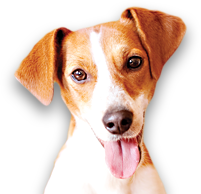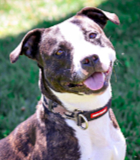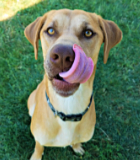Teaching Your Dog Not to Jump Up on People
- This topic has 0 replies, 1 voice, and was last updated 14 years, 11 months ago by
Mackenzie’s Admin.
-
AuthorPosts
-
June 17, 2010 at 3:55 pm #535
Mackenzie’s Admin
MemberPuppies and dogs naturally jump up on people when they say hello. Why? Because we’re taller than they are! When dogs meet, they sniff each other’s faces. They like to do the same thing when greeting us, so it’s perfectly natural for dogs to jump up on us to try to reach our faces and get our attention.
What to Do About the Problem
The key to teaching your dog not to jump on you when she greets you is to tell her that you only greet dogs who keep their front paws on the floor. Although you can’t tell her with words, you can tell her with actions. When your dog greets you, her goal is to get your attention and to get you to pet her. Knowing this, you can show your dog what she must do to earn your attention and touch. Try to remember two things each time you greet your dog:Keep your attention and your hands away from your dog unless her front feet are on the floor.
Immediately give your dog attention and petting the instant her front feet land on the floor.
For instance, when you enter a door and your dog jumps up on you, ignore her. Don’t tell her to get off you and don’t push her away. Instead, stand up straight and look over her head. If you move your arms and hands at all, pull them up toward your chest. If she continues jumping all over you, turn away. She’ll have to put her front paws on the floor to follow you. The instant her front paws touch the floor, melt into the wonderful loving owner that you are, and say “Good girl” quietly and pet her head. If she jumps up at your touch, just pull your hand away, stand up straight like before, and ignore her until her feet find the floor once again. The moment her feet touch the floor, pet her. Your attention and your touch are the words that you can use to let your dog how she needs to act to get your attention.Never withhold attention when your dog’s feet finally do touch the floor—even if you’re irritated at her for jumping a moment earlier. She has to be able to make the connection that front feet on the floor magically result in attention and affection from people.
Training Exercises
It’s important to teach your dog what you do want her to do during greetings. For example, you can train her to sit or stand to greet people instead of leaping all over them. (For detailed information about how to teach your dog to sit when you ask her to, please see our article, Teaching Your Dog to Sit.) The following exercises can help your dog learn to greet you and others politely:When your dog starts to jump up, stand still, look straight ahead (not at your dog), and pull your hands and arms up to your chest. Calmly wait for your dog to stop jumping. When her front paws touch the floor, immediately look at her and calmly stroke her. If she gets excited and jumps up again, straighten back up and repeat the sequence.
If your dog already knows how to sit on cue (command), try this step. When your dog starts to jump up, stand still, look straight ahead (not at your dog), and pull your hands and arms up to your chest. Say “Off” and immediately turn your back to your dog so that she can’t reach your face. Then say “Sit.” When she sits (watch her in your peripheral vision so that you can see), turn back around to face her, kneel down and calmly stroke her. If your dog jumps up again, quickly stand up and turn your back on her as you did before. Keep repeating this sequence until your dog stops jumping up.
If you’re entering a room and your dog starts to jump up, immediately step back outside and close the door behind you, leaving it open just a crack. Through the crack in the door, say “Sit.” When your dog sits, calmly walk back into the room, kneel down and gently stroke her. If she jumps up again, quickly stand up and walk right back out of the room again, closing the door behind you. Keep repeating this sequence until your dog stops jumping up.
When your dog starts to jump up, stand still, look straight ahead (not at your dog), and pull your hands and arms up to your chest. Say “Off,” and take a few quick steps toward your dog. (Be careful to not step on her toes.) She’ll jump back to get out of your way. The instant her front paws are on the floor, say “Sit.” When she sits, kneel down and calmly stroke her. If she jumps up again, immediately stand up and repeat the sequence.Once your dog has learned to greet you politely, recruit several friends to help you teach your dog to greet visitors politely as well. One at a time, have your friends practice the exercise above that starts with the person entering the house or room. Explain the sequence to them: turn their back, walk out and close the door if your dog jumps on them. Then start your practice session with one of them knocking or ringing the bell, and go with your dog to answer it. Before you open the door, tell your dog to sit. When she does, open the door. If your dog jumps, your friend knows what to do. If your dog stays sitting, your friend can calmly greet her and you can praise and treat her. Have each of your friends do several repetitions.
Additional Tips
Because of their extreme excitement when greeting people, some dogs find it easier to grab a toy to shake or hold, rather than sit for petting. If this sounds like your dog, keep a toy by the front door. When you come home, open the door and immediately direct your dog’s attention to the toy or throw it for her. Do the same thing for your dog when visitors come to your home.Because teaching your dog not to jump can be challenging, don’t hesitate to enlist the help of a Certified Professional Dog Trainer (CPDT) in your area. A professional trainer will offer group or private classes that can give you and your dog lots of help with jumping issues. Please see our article, Finding Professional Help, to locate a CPDT.
If your dog shows signs of aggression, such as growling or teeth showing while lunging or jumping toward you, your family members or visitors during greetings, you should seek the assistance of a Certified Applied Animal Behaviorist (CAAB or Associate CAAB), a veterinary behaviorist (Dip ACVB) or a qualified Certified Professional Dog Trainer (CPDT) who has experience treating aggression. Please see our article, Finding Professional Help, for information about locating a behaviorist or a CPDT for guidance. If you elect to hire a CPDT because you can’t find a behaviorist in your area, be sure to determine whether she or he has professional training and extensive experience in successfully working with aggression, as this expertise isn’t required for CPDT certification.What NOT to Do
Do not become really excited when you greet your dog. The calmer you are, the calmer your dog will be.
Do not shout at your dog when she jumps up on you or others. Shouting will just make her more excited and cause more jumping up.
Do not try to grab your dog or push away. Doing that could just cause more jumping up.
Do not knee your dog in the chest, step on her back toes, grab or pinch her front toes, or otherwise cause her pain or discomfort. If you do, you’ll frighten and hurt your dog, and she still won’t have learned how to politely greet people. -
AuthorPosts
- You must be logged in to reply to this topic.











































